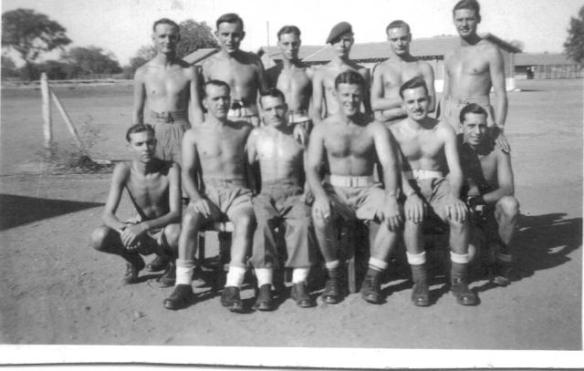
Nicknamed “Soggy”
Date Founded: June 1944
Mission When Founded: Provide small parties of uniformed troops trained and equipped to operate in enemy coastal, river and lake area using small craft, inflatable boats, paddle boards or swimmers
Mission During the War: Unchanged
Theatre(s) of Operation: South East Asia Headquarters: Fort Hammenhiel, Karaitivu island, Ceylon
# of Personnel: 345 all ranks (1945)
HISTORY:
The Small Operations Group was formed in June 1944 to bring together the disparate amphibious units assembling in the Far Eastern theatre under one command, and to apply the lessons learnt in Europe and the Mediterranean to the Japanese. SOG was headquartered at Admiral Mountbatten’s South East Asia Command [SEAC] headquarters, and continued Mountbatten’s predilection for unconventional warfare formed whilst commanding Britain’s Combined Operations. SOG was the first attempt to co-ordinate the activities of units that previously operated as “private armies”.
SOG was commended by Colonel H. T. Tollemache RM, and Blondie Hasler was transferred from the RMBPD, promoted to Lieutenant-Colonel and made second in command with responsibility for training. SOG consisted of COPP 7 and 8, SBS groups A and B, the Sea Reconnaissance Unit and RM Detachment 385. Although highly trained in their respective specialities, once in Ceylon all SOG members were given intensive training in jungle warfare and survival, day and night navigation and endless training embarking/disembarking submarines, destroyers, motor launches and Catalina flying boats.
Burma’s rivers and coastline provided the ideal location for SOG’s units to demonstrate their talents. Of SOG’s 173 operations, over 80 were on Burma’s west coast alone. Later operations expanded to Malaya, Siam and Sumatra. SOG performed two types of mission: “Independent operations” and “Force Commanders’ Operations”. An Independent operation was what it was named – the SOG commander was responsible for planning and execution. On a Force Commander’s Operation, a team was detached to the formation HQ for a major operation. SOG was only responsible for team selection and liaison. Only 19 of SOG’s operations were independent – the rest were force commanders’ operations.
COPP 7 and 8 had arrived in India in November 1943. For operations the COPPs were always attached to Force W – the naval amphibious force. Due to operational demands and the unhealthy waters of the Arakan, COPPs 7 and 8 rotated with COPPs 1, 3, 4 and 9 in 1945.
The remaining units of SOG worked with 3 Commando Brigade, the 14th Army and XV Corps. They performed reconnaissance, intelligence gathering including prisoner snatches, defence clearance, diversionary raids and jitter parties for SEAC, although SOG’s official history notes that HQ struggled at times to find suitable targets for SOG’s raiders. SOG’s operations were usually made at night as boats are easily spotted during the day, dodging patrolling Japanese motor sampans.
SBS teams operated with V Force (1), a locally raised intelligence force, and Force 136 (2), SOE’s guerrilla operation – resupplying, bringing in team members and commanding local guerrillas.
The Sea Reconnaissance Unit was founded by Lieutenant Commander Bruce Wright of the Canadian Naval Reserve and an Olympic swimmer in December 1942. The SRU’s mission was reconnaissance and attack by long-distance swimmers on paddle boards similar to Malibu-style surf boards. The swimmer and three metre board would be dropped by parachute 20 miles from the target. Equipped with hand paddles the swimmer would make his way to the target using the board’s compass.
Initial training was at the US Marines’ Camp Pendleton, San Diego, but sharks and cold water restricted swimming to 5-10 miles. The SRU moved to warmer Nassau, Bahamas in 1943 for more intensive training. Sea training was completed in March 1944, and consisted of 48 men all ranks. By then the SRU’s proposed missions for the Aegean and the Adriatic were cancelled and the unit reoriented for Asian seaborne roles and was assigned to SOG.
The SRU started operations in 1945, working in 10-man sections, plus porters for the boards, and performed recces ahead of Allied advances and cleared Japanese defences. SRU’s most valuable contribution to British seaborne raiding were long swimming fins and the American-pattern single-window diving mask soon adopted by all British combat swimmers. The unit was disbanded at the end of the war.
Royal Marine Detachment 385 was created in the summer of 1944, and became operational in March 1945. The 122-strong unit consisted of canoeists and parachutists. Organised into three sections suited to specific operations, Detachment 385 performed deception raids, Japanese prisoner snatches and landed agents and stores for guerrillas, and generally acted as SOG’s general purpose unit. The unit’s first operation was almost its last when six men were lost, and eight of its 18 missions were failures.
(1) V Force was a guerrilla force run by the British Army, and assembled from Ghurkha platoons of the Assam Rifles augmented by 1,000 hill tribesmen. Originally conceived as a “stay-behind” force in the event of Japanese invasion; its role changed to that of intelligence gathering and the maintenance of outposts ahead of the advancing main British units. V Force’s officers were appointed on the basis of expert knowledge of the local language and peoples rather than rank.
(2) Force 136 was the cover name for the Special Operations Executive in the South East Asian theatre. First named GS I(k) it became Force 136 in March 1946. Most of Force 136 agents were Malaysian, Chinese, Thai and Burmese. Force 136 utilised native resistance to the Japanese occupation by organising local resistance movements. Force 136 also organised more conventional military operations behind Japanese lines.
BIBLIOGRAPHY
Ladd, James – 1978. Commandos and Rangers of World War II. St. Martin’s Press.
Messenger, Charles – 1985. The Commandos 1940-1946. William Kimber.
Thompson, Julian – 1998. The Imperial War Book of War behind Enemy Lines. Sidgwick & Jackson.